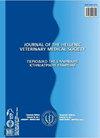黑孜然种子对日本鹌鹑胴体特性、肾脏抗氧化水平和回肠组织形态的影响
IF 0.4
4区 农林科学
Q4 VETERINARY SCIENCES
引用次数: 0
摘要
本研究旨在研究在鹌鹑饲料中添加不同剂量黑孜然种子(NS)对鹌鹑胴体特性、肾脏抗氧化水平和回肠组织形态的影响。将432只3日龄混合性日本鹌鹑随机分为4组。各组分别饲喂基础饲粮(对照组)和基础饲粮中分别添加0.5% (NS-0.5组)、1% (NS-1组)和2% (NS-2组)的NS。结果表明,NS-2组大鼠背部和颈部重量降低,NS-1和NS-2组大鼠头部重量和比例降低。与对照组和其他NS组相比,NS-0.5组的大腿率增加。与对照组相比,NS组雄性鹌鹑肾谷胱甘肽、谷胱甘肽过氧化物酶和过氧化氢酶值均升高。与对照组相比,只有NS-2组的肾脏维生素C增加。NS-2组的绒毛高度和雌鹌鹑的绒毛高度均降低,而绒毛宽度仅在雌鹌鹑中降低。结果表明,饲粮中添加0.5%的NS可提高大腿率,饲粮中添加三种不同剂量的NS可有效维持肾脏氧化-抗氧化平衡,除了饲粮中添加2%的NS外,回肠组织形态没有发生变化。由此可见,黑孜然籽可作为鹌鹑日粮中的天然抗氧化源。本文章由计算机程序翻译,如有差异,请以英文原文为准。
The effects of black cumin (Nigella sativa l..) seed on carcass characteristics, kidney oxidant antioxidant levels and ileum histomorphology in Japanese quails
This study aims to determine the effects of supplementation of different doses of black cumin seeds (NS) to quail feeds on carcass characteristics, kidney oxidant antioxidant levels, and ileum histomorphology. A total of 432 mixed-sex three days old Japanese quails were randomly divided into four groups. The groups were fed on either a basal diet alone (Control Group) or a basal diet supplemented with NS at rates of 0.5% (NS-0.5 Group), 1% (NS-1 Group), and 2% (NS-2 Group). It was determined that the back+neck weight in the NS-2 group and head weight and ratio in the NS-1 and NS-2 groups decreased. The thigh rate increased in the NS-0.5 group compared to the control and other NS groups. Kidney glutathione, glutathione peroxidase, and male quails' catalase values were increased in NS groups compared to the control group. The kidney vitamin C increased only in the NS-2 group compared to the control. In the NS-2 group, the villus height decreased both on a group basis and in female quails, while the villus width decreased only in female quails. Consequently, it was determined that dietary supplementation of NS at rates of 0.5% increased the thigh rate, dietary supplementation at three different doses of NS were effective in maintaining the kidney oxidant-antioxidant balance, and the ileum histomorphology did not change except for dietary supplementation of NS at rates of 2%. Therefore, it can be stated that black cumin seeds can be used as a natural antioxidant source in the quail diet.
求助全文
通过发布文献求助,成功后即可免费获取论文全文。
去求助
来源期刊

Journal of the Hellenic Veterinary Medical Society
VETERINARY SCIENCES-
CiteScore
0.60
自引率
0.00%
发文量
83
审稿时长
>12 weeks
期刊介绍:
The Journal of the Hellenic Veterinary Medical Society (J Hellenic Vet Med Soc) is a quarterly peer-reviewed journal that publishes articles in all aspects of veterinary science and related disciplines. It is published by the Hellenic Veterinary Medical Society and is indexed in the Web of Science and in Scopus.
There are no publication fees in the journal. Authors considering submitting manuscripts for evaluation and publication are requested to read carefully the instructions for authors and fully comply with them.
Non-complying manuscripts may be returned to the corresponding author for formatting.
 求助内容:
求助内容: 应助结果提醒方式:
应助结果提醒方式:


